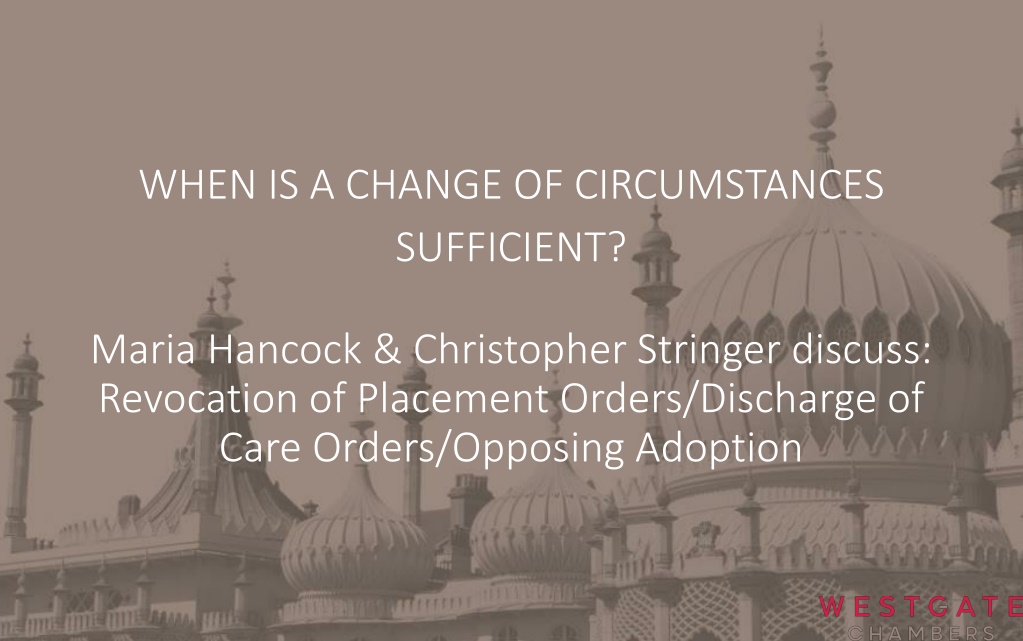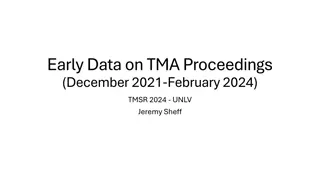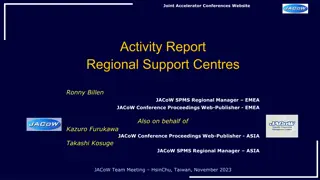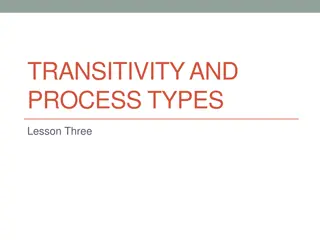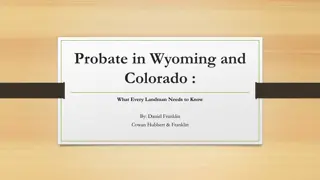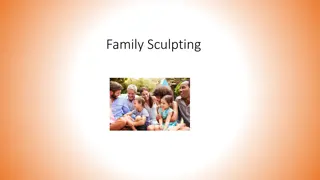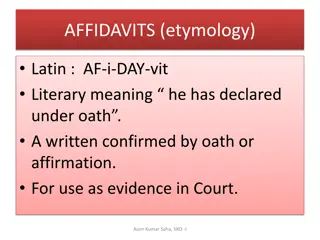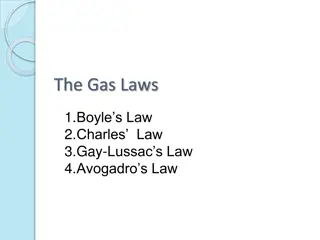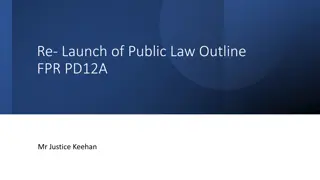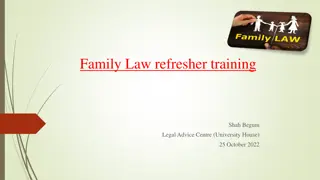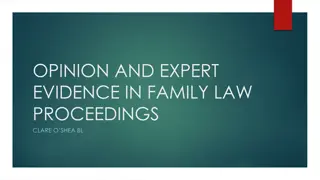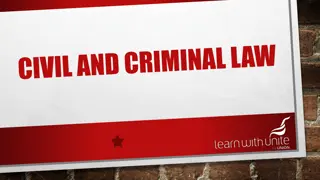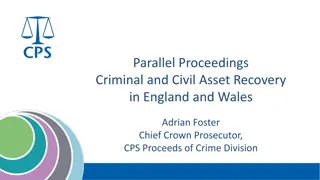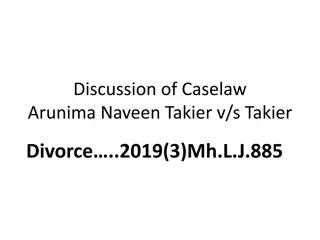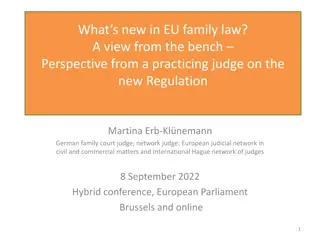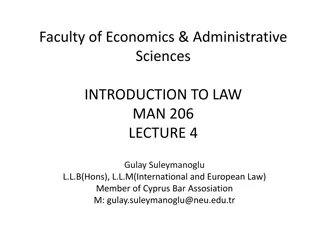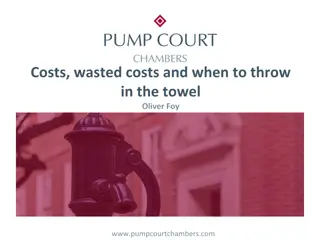Change of Circumstances in Family Law Proceedings
In family law cases involving revocation of placement orders, discharge of care orders, or opposition to adoption, a change of circumstances is crucial for seeking permission from the court. The change doesn't have to be significant but should be of a nature to warrant consideration. Ultimately, the welfare of the child is the primary concern, and maintaining connections with birth parents is essential unless proven otherwise.
Download Presentation

Please find below an Image/Link to download the presentation.
The content on the website is provided AS IS for your information and personal use only. It may not be sold, licensed, or shared on other websites without obtaining consent from the author.If you encounter any issues during the download, it is possible that the publisher has removed the file from their server.
You are allowed to download the files provided on this website for personal or commercial use, subject to the condition that they are used lawfully. All files are the property of their respective owners.
The content on the website is provided AS IS for your information and personal use only. It may not be sold, licensed, or shared on other websites without obtaining consent from the author.
E N D
Presentation Transcript
WHEN IS A CHANGE OF CIRCUMSTANCES SUFFICIENT? Maria Hancock & Christopher Stringer discuss: Revocation of Placement Orders/Discharge of Care Orders/Opposing Adoption
WHEN IS A CHANGE OF CIRCUMSTANCES SUFFICIENT TO: 1) 2) 3) Apply for permission to revoke a Placement Order; Apply to Discharge a Care Order; Apply for permission to oppose an Adoption Order.
[Discussion of N (Children: Revocation of Placement Orders) [2023] EWCA1352 and Re C (Children) (Revocation of Placement Orders) [2020] EWCA Civ 1598)]
Applying for permission to revoke a Placement Order: The law (1) The court may revoke a placement order on the application of any person. (2) But an application may not be made by a person other than the child or the local authority authorised by the order to place the child for adoption unless (a) the court has given leave to apply, and (b) the child is not placed for adoption by the authority. (3) The court cannot give leave under subsection (2)(a) unless satisfied that there has been a change of circumstances since the order was made.
The change in circumstances does not need to be significant but it does need to be of a nature and degree sufficient to open the door to a consideration of whether permission to apply should be given. This principle derived from the Court of Appeal decision in Re P (Adoption: Leave Provisions [2007] EWCA Civ 616, [2007] 2 FLR 1069 At the second stage, the child s welfare is relevant but not paramount (M v Warwickshire County Council [2007] EWCA Civ 1084, [2008] 1 FLR 1093. If permission is granted, the substantive application to revoke the Placement Order must be determined by applying S1 of the 2002 Act.
The following principles can be distilled from the relevant authorities: (a) the paramount consideration for a court when considering an outcome for a child is that child s welfare; (g) To arrive at that conclusion the possibility of parental care or, in the alternative, care by members of the wider birth family must be shown to be options which are not realistic either by reason of unavailability (i.e. they do not exist) or because such care cannot meet the welfare needs of the child. (b)it is a principle of the law that the welfare of a child is best met by maintaining the connection with birth parents to as full an extent as possible; (h)That option of parental or family care should not be rejected if identified deficits could be remedied through appropriate and proportionate support provided by the Local Authority, even if such support would be necessary for an extended period of time. (c) that principle is underpinned by application of the least interventionist principle enshrined in s.1(6); (d)adherence to those principles reflects and respects both the importance of the right to family life set out in Article 8(1) of ECHR and the limited scope for interference with that right as set out in the exceptions in Article 8(2); (i) In order to arrive at a valid conclusion that a child s welfare requires their permanent removal from parental/family care it is necessary to consider individually all of the competing options for care, to assess their respective strengths and weaknesses and then to look at those options against each other to ensure that every option is fully considered against (e)interference in the right to family life, which is the right both of the parent and of the child, is parametered by necessity, proportionality and legality. every other option. (j) Having done so and identified the outcome most able to meet the welfare needs of the child it is necessary to consider whether that outcome is itself a proportionate interference in the rights of the child. (f) As a consequence, the permanent severing of ties between a child and her birth parents is an outcome only to be ordered in exceptional circumstances and where motivated by overriding requirements pertaining to the child s welfare.
Demographics: On the Rise. Applications for discharge have substantially increased in the last decade, from 71 in England in 2010 to 1589 in 2019, and from 61 in 2012 to 138 in 2019 in Wales. The increases in discharge applications partly reflect increases in the number of care orders in both England and Wales.
Who is making the applications? The majority of discharge applications (60 70%, depending on the data source) were made by local authorities. Of the remaining applications, the vast majority were made by parents. Very few applications were made by children, for example in the e- casefile data just one application was made by a child. Of the 69% of discharge applications made by local authorities in the e- casefiles: 61% were for children to live with a parent or both parents. 39% were intended to result in a SGO to the current carers, most of whom were related to the child.
Timing of discharge applications On average, discharge applications were made at least two years after the initial care order. However, the range of care order length was large discharge applications were made between 2-147 months from the initial care order. Why the range?
Application success rate: 25% of parent applications were successful compared with 95% of LA applications. What factors impact likely application success? The recommendation made by the guardian was the most influential factor in predicting the discharge outcome. Of the 203 e-casefile cases where the guardian s recommendation was known, the outcome was congruent with that recommendation in 201 cases. The child s preference about where to live was positively associated with the discharge outcome. A higher number of concerns about parenting capacity and lifestyle at discharge was associated with the application being refused. Parent applications were less likely to be discharged if there had been multiple forms of abuse at the time of the care order.
Inconsistencies in approach. Legal representation. Interviewees felt that the discharge process could be re- traumatising for the families and children involved. Ulterior motives to achieve different ends.
Recommendations. Development of national guidance on thresholds to reduce inconsistency. Local authorities to promote active case management. Guardians to engage children. Children have the right to be involved in matters affecting them (UNCRC 1989). Advice about discharge to be made available for parents, carers and children. Financial and practical support to be provided to SGO carers.
Children Act provision for Discharge of Care Orders Section 39 Discharge and variation etc. of care orders and supervision orders. (1) A care order may be discharged by the court on the application of (a) any person who has parental responsibility for the child; (b) the child himself; or (c) the local authority designated by the order. (2) (3B) (4) Where a care order is in force with respect to a child the court may, on the application of any person entitled to apply for the order to be discharged, substitute a supervision order for the care order. (5) When a court is considering whether to substitute one order for another under subsection (4) any provision of this Act which would otherwise require section 31(2) to be satisfied at the time when the proposed order is substituted or made shall be disregarded."
Welfare Checklist Section 1 (3) Children Act In the circumstances mentioned in subsection (4), a court shall have regard in particular to [Welfare Checklist] Section 1(4) Children Act The circumstances are that [ ] (b) the court is considering whether to make, vary or discharge a special guardianship order or an order under Part IV.
Convention Rights and the Human Rights Act 1998 In re B (A Child) (Care Proceedings: Threshold Criteria) [2013] 1 WLR 1911 at paragraphs 62, 73 and 194. A proper application of the welfare test will normally produce an outcome that is compatible with Convention rights, by having particular regard to the child's background (checklist factor d), his emotional needs (factor b) and any risk of harm (factor e). And, of course, consideration of the position of the child's parents is mandatory (factor f). But on top of this, once the welfare evaluation has been carried out, the court will cross-check the outcome to satisfy itself that it is exercising its powers in such a way that any resulting interference with Convention rights is necessary and proportionate. This cross-check does not alter the fact that the decision turns on welfare and not on rights or presumptions: see Re W (A Child) [2016] EWCA Civ 793; per McFarlane LJ at 70-71. In judicial decisions where the Article 8 rights of parents and those of a child are at stake, the child's rights must be the paramount consideration; if any balancing of interests is necessary, the interests of the child must prevail: Yousef v The Netherlands (2003) 36 EHRR 20.
In Re S (Discharge of Care Order) [1995] 2 FLR 639, Waite LJ said this at 643: "Section 39 of the Act allows the court to discharge a care order on the application of (inter alios) a parent. Here the jurisdiction is discretionary from the outset (there being no obligation on the parent to satisfy the court that the threshold requirements no longer apply). The issue has to be determined by the court in accordance with s 1 of the Act, which (by s 1(1)) makes the child's welfare the court's paramount consideration, and (by s 1(3) and (4)) makes it mandatory for the court to have particular regard to the child's wishes and needs, the likely effect on him of any change of circumstances, the capability of his parents to meet his needs, the range of powers available to the court and, specifically: '(3) . . . (e) any harm which he has suffered or is at risk of suffering; ...'"
Re C (Care: Discharge of Care Order) [2009] EWCA Civ 955, was an unusual case in which a local authority had successfully applied for the discharge of a care order and a parent appealed on the basis that the care order should have continued so as to give the child the benefit of the 'leaving care' provisions. The judgment of Hughes LJ included this passage: "[17] The test upon an application for discharge is clearly set out by this court as long ago as 1995 in Re S (Discharge of Care Order) [1995] 2 FLR 639 at 643. As Waite LJ put it: 'Section 39 of the Act allows the court to discharge a care order on the application of (inter alios) a parent. Here the jurisdiction is discretionary from the outset (there being no obligation on the parent to satisfy the court that the threshold requirements no longer apply). The issue has to be determined by the court in accordance with s 1 of the Act, which (by s 1(1)) makes the child's welfare the court's paramount consideration ' [18] I entirely agree that the applicant for such an order must make out his case. It does not follow from that that the test is simply a matter of listing potential benefits. Welfare is a more complicated and rounded consideration than that. I am quite satisfied that the judge is entitled to take into account the continuing effect, or in this case lack of effect, of the care order."
TT TT (Children (Children: : Discharge Discharge of of Care Care Order) Order) [ [2021 2021] ] EWCA EWCA Civ Civ 742 742 In summary, when a court is considering an application to discharge a care order the legal principles are clear: (1) The decision must be made in accordance with s. 1 of the Act, by which the child's welfare is the court's paramount consideration (2) Once the welfare evaluation has been carried out, the court will cross-check the outcome to ensure that it will be exercising its powers in such a way that any interference with Convention rights is necessary and proportionate. (3) The applicant must make out a case for the discharge of the care order by bringing forward evidence to show that this would be in the interests of the child. The findings of fact that underpinned the making of the care order will be relevant to the court's assessment but the weight to be given to them will vary from case to case. (4) The welfare evaluation is made at the time of the decision. The s. 31(2) threshold, applicable to the making of a care order, is of no relevance to an application for its discharge. The local authority does not have to re-prove the threshold and the applicant does not have to prove that it no longer applies. Any questions of harm and risk of harm form part of the overall welfare evaluation.
Part III Applying for permission to oppose an Adoption Order
The test for the grant of permission is the same as that when seeking permission to apply to revoke a Placement Order (see paragraph 4 above). S47 of the 2002 Act provides (inter alia): 3) A parent or guardian may not oppose the making of an adoption order . . . without the Court s leave; 7) The Court cannot give leave . . . unless satisfied that there has been a change of circumstances since the consent of the parent or guardian was given or, as the case may be, the placement order was made.
The principle as to the nature and degree of circumstances required ie significant (as above) was identified by the Court of Appeal in Re P (Adoption: Leave Provisions) [2007] EWCA Civ 616, [2007] 2 FLR 1069. It has been re-affirmed recently by Jackson LJ in the case of Re M (A Child: Leave to Oppose Adoption) [2023] EWCA Civ 404. The two-stage hurdle was confirmed: a) the applicant must establish a change of circumstances since the Placement Order was made, and b) he must persuade the Court that it is in the child s welfare interests for leave to oppose be granted. The question is should the Court revisit the plan of adoption and is this in the child s welfare interests?
Conclusion Conclusion The test to be satisfied in all of the above applications remains 1) sufficient change of circumstances and 2) welfare of the child. When is sufficient, sufficient? The relative rarity of the authorities in this area suggests that the answer may be not very often.
WHEN IS A CHANGE OF CIRCUMSTANCES SUFFICIENT? Maria Hancock & Christopher Stringer discuss: Revocation of Placement Orders/Discharge of Care Orders/Opposing Adoption
